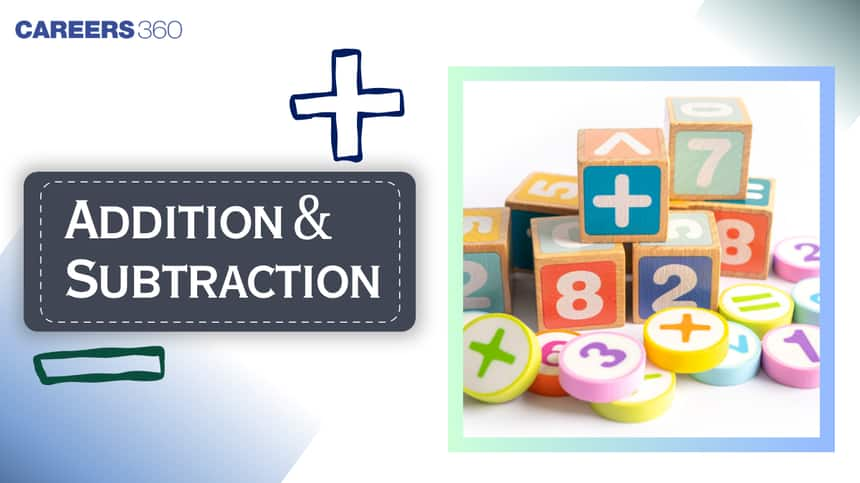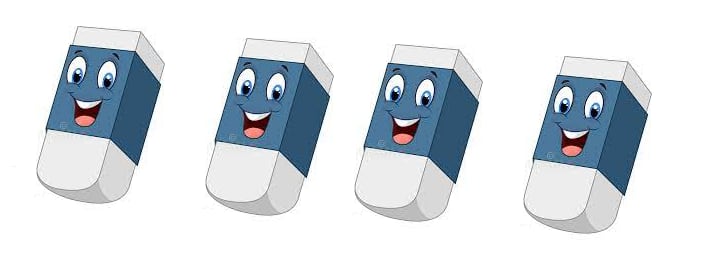Addition And Subtraction
Addition and subtraction are part of the calculation in math. Addition and subtraction are opposite of each other. The addition is combining multiple things and counting them as one large group. In mathematics, the process of combining two or more numbers is called addition. The numbers added are addends, and the final answer is called the sum. (It is usually signified by the plus symbol +) Whereas subtract means to take away from a group or number of things. In mathematics, subtracting means the number of things in the group becomes less or reduces. The parts of subtraction are minuend, subtrahend, and difference. (The “-” negative symbol usually signifies it).
This Story also Contains
- Addition And Subtraction Sum
- Addition, Subtraction And Multiplication
- Addition And Subtraction For Classes 4 And 5
- Addition To The Kindergarten Class

Addition And Subtraction Sum
Addition and subtraction are inverse operations of each other. As an illustration, if 9 + 1 = 10, then 10 - 1 = 9. That demonstrates that adding one to 9 shows a result of ten, but subtracting one from 10 shows a result of nine.
A new number is created by adding two or more additional numbers or values. As an illustration, the outcome of adding 2 and 3 is 5.
2 + 3 = 5
Let's now look at the sum of 2 and 3 practically. What number of apples are there in total if we start with two apples in a basket and then add three more?
2 → 1 + 1
3 → 1 + 1 + 1
2 + 3 = 1 + 1 + 1 + 1 + 1
Counting each apple separately yields a total of 5 apples.
If we now count each apple, there are 5 total.
The ability to add to an existing value results in a rise in value.
To subtract is to take away another value to obtain the desired value.
For instance, 2 is the result when 3 is subtracted from 5.
5 - 3 = 2
How many apples are left in the basket if we believe there are 5 apples in it, and we take out 3 of them?
So, the answer is 2 apples.
5 - 3 = 1 + 1 + 1 + 1 + 1 - 1 + 1 + 1 = 2
Addition, Subtraction And Multiplication
As we see above, the four major operations in mathematics are:
Addition
Subtraction
Multiplication
Division
Like addition and subtraction, multiplication and division are also inverse operations of each other.
Let us understand with an example,
If 3 is multiplied by 4,
3 x 4 = 12
So, the answer will be 12.
Now, if 12 is divided by 3,
12 ÷ 3 = 4.
Here, the answer is 4.
Addition And Subtraction For Classes 4 And 5
Grade 4 addition, involves the addition of digits like single digits, two digits, three digits etc. Let's understand more.
Mental Addition-
Mental addition is the calculation (addition) of two different or the same values in mind (directly).
Some examples of mental addition are given below,
Sum of 2-digit numbers
23 + 24 = 47
Here, we can easily do a sum of 23 and 24 in mind.
Sum of three different values( two-digit numbers)
10 + 11 + 12 = 33
Adding in Columns-
For some additions, we need to do the sum of given values by putting them as Columns; let's see,
Sum of 3 digit numbers
123 + 345 =?
So, for the given addition, we have to put this in the column first
123 + 345 = 468
Another example
456+324 = 780
Here, the sum of the last digits 6 and 4 is 10. So, their sum result is 0 and 1 will be added at the left-sided digit (i.e 5) of 6.
Another example of the addition of three big three-digit numbers is given below,
789+ 687+ 879= 2355
So, 2 + 8 + 8 + 7 = 25. Now the same as above. 5 will be down, and 2 will be added to the left-side column of the digit 8 in 789.
So, the sum of 2 + 7 + 6 + 8 = 23
Now, for the subtraction process, we will take 2, 3, 4, 5, or 6-digit numbers. Let's understand with an example,
Subtraction of 234 and 123
234 - 123 = 111
We’ll take some more examples to understand subtraction.
159 - 031 = 128
Let us understand how the subtraction mechanism works.
For example, 159 - 031,
Now, to find the answer, we’ll write numbers like this,
1 5 9
- 0 3 1
? ? ?
The first step is to subtract from the value's right side. So, we’ll do a subtraction of 9 and 1. So, 9 - 1 = 8.
1 5 9
- 0 3 1
? ? 8
As the next step, we’ll subtract the left side number of 9. So, for 5 and 3, 5 - 3 = 2.
1 5 9
- 0 3 1
? 2 8
Now, at the last step, the left-sided number of 5. So, 1 - 0 = 1.
1 5 9
- 0 3 1
1 2 8
This is how the subtraction mechanism works.
Addition To The Kindergarten Class
Let us understand addition and subtraction,
Addition
The sum of the given value is called addition. See the given images.
Let us consider that Rahul has 1 apple and Ashok has 1 apple. Now, Ashok gives his 1 apple to Rahul. Then how many apples does Rahul have now? The answer is 2 apples.
Let us learn more with another example.

https://www.vectorstock.com/royalty-free-vector/cartoon-eraser-vector-5617700
How many erasers are there in the image? Let us count erasers.
Let’s count erasers. There is 1 eraser, then another 1, and then another 1 and then another 1.
So, the numbers of erasers are 1 + 1 + 1 + 1 = 4.
There are 4 erasers in the image.
Now, we learn addition without using images. The followings are the calculations of addition,
1) Addition or sum of 0 and 1
0
+1
1
2) Sum of 1 and 2
1
+2
3
3) Sum of 3 and 4
3
+4
7
So, this is how we can do the sum of two different or the same numbers in mathematics, which is called addition.
Frequently Asked Questions (FAQs)
The process in which we add or do a sum of two or more items or numbers of things is called addition. For example, Ayush has 12 bananas, and the prince has 1 banana. So, If the prince gives his banana to Ayush, the total number of bananas Ayush has will be 13. At the same time, the process in which we remove or minus or subtract things or items or numbers is called subtraction. For example, Ayush gives his 12 bananas to the prince. So, now Ayush has 0 bananas.
Yes, addition and subtraction are inverses of each other. Adding 3 with 2 will gives us an answer as 5 and again subtracting 2 from 5 will gives us an answer as 3. The addition is the process in which two values combine and form a new value. A small value is taken from a bigger value in the subtraction process.